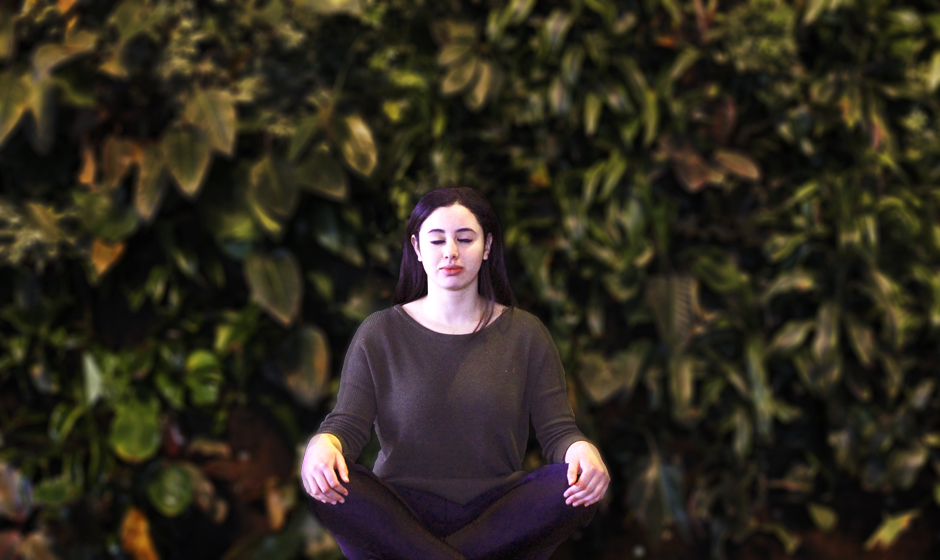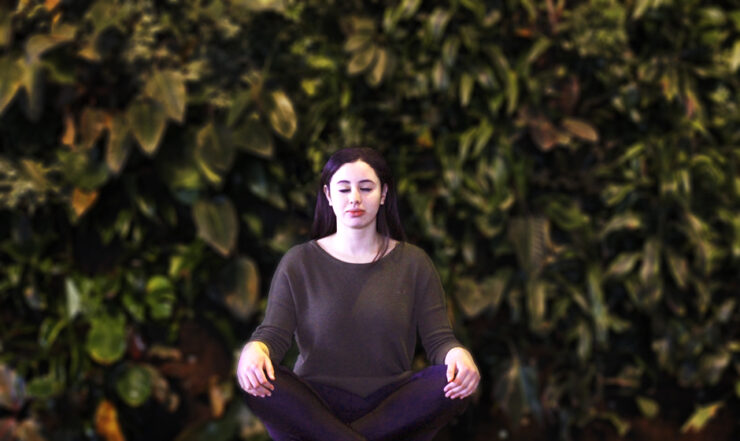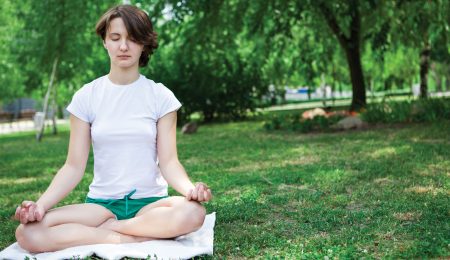 How the age-old practice of mindfulness can help cope with modern stresses
How the age-old practice of mindfulness can help cope with modern stresses
Photo by Marta Kierkus
It’s another difficult morning before that early Friday class. Into the shower you go; it really seems to wake you up so that’s the first thing you do while you ponder last evening’s events—wait, did you shampoo your hair already? Oh well, it’s time for breakfast anyway.
As you mow down your morning cereal, you read a lengthy, impassioned article in the Fulcrum about… wait, what was the article about again? And hold on—are you sure it was cereal that you were having? Not oatmeal… or a muffin? Are you sure you even ate?
With so many distractions—people, things, noises, flashing lights— vying for our attention at any given moment, it is harder than ever these days for people to be present in the present.
The boredom of our childhood, when we actually had to think of things to do—times that inspired such creative enterprises as “dark tag,” or “grounders,” or perhaps our finest Crayola self-portrait—can now be wholly avoided by applying pressure on a touchscreen. While technology has made it possible to engage our minds more quickly, the rapid brain processes needed to keep up with the modern condition can leave behind seemingly insignificant memories like words and breakfast.
A solution steeped in age-old wisdom exists for this modern issue: mindfulness.
The meaning of mindful
“Mindfulness means slowing down,” says Dr. Heather MacLean, a neurologist at the Ottawa Hospital and leader of the mindfulness curriculum working group for the University of Ottawa’s Faculty of Medicine.
It means “purposely paying attention to all aspects of the reality of what is happening now and not being completely lost in your own thoughts and swept away by your mind’s opinions and judgments,” says Dr. MacLean.
Mindfulness means opening yourself up to the daily train of emotions, thoughts, and ideas that one experiences, without filter. For example, being mindful can mean focusing on the physical sensations of a hot shower in the morning, the gentle spray of water on your face, the scent of your shampoo and your body literally warming up, rather than being lost in planning for the day or worrying about an upcoming exam.
Or, being mindful can mean paying more attention to the people around you, which could involve concentrating more on your conversations and less on what else you should be doing, or looking more often at the faces of those you’re talking to, and less at your phone and surroundings.
“The definition of mindfulness that I like to use is the following: paying attention in the present moment, on purpose, and in a particular way, with qualities such as curiosity, compassion, and acceptance,” says Dr. MacLean.
Mindfulness practice by the average student can ground an otherwise harried and chaotic existence in the university environment.
Art Assoiants, a mindfulness facilitator with the Healthy Student Initiative and a psychology student at York University, recognizes the difficulties students face.
“The American College Health Association has found that, as a general whole, the student body of Canada’s universities is not in a good place,” says Assoiants.
“Students undergo a great deal of stress and anxiety and a number of them have sleep difficulties. Mindfulness meditation is one of the ways to manage this startling finding.”
Looking to the past for a modern problem
Mindfulness is derived from traditional Buddhist meditation practice dating back 2,500 years. Modern proponents of the practice have been quick to adapt mindfulness to the current day, emphasizing its ability to help alleviate stress and improve concentration.
Recently, the practice has rapidly gained traction in the world of healthcare, in education, and even the corporate world, with veritable household names such as Google, LinkedIn, and a wealth of Fortune 500 companies incorporating the practices for professional development.
Its widespread acceptance perhaps indicates a collective agreement on our part for the need to slow down and truly experience life. But its promises of increased productivity, efficiency, and happiness have enthralled the masses, making it questionable whether practitioners today really understand the deeper meaning behind mindfulness. Critics have argued that mindfulness practices are simply knee-jerk responses to a society that has become too busy, needy, materialistic, and expects too much from itself.
In an essay appearing in Cabinet Magazine, philosopher Slavoj Žižek said mindfulness and other forms of Western Buddhism justify our full participation in the frantic pace of the capitalist game because we sustain the perception that we are not really in it. Žižek argues that these practices suggest we understand how worthless the spectacle of our society is, but that we accept it because “what really matters to you is the peace of the inner Self to which you know you can always withdraw.”
Critics argue mindfulness does nothing to address the underlying issues behind the frantic modern condition of our thinking patterns. On the contrary, they say it encourages the status quo by providing a medium through which to lose the tensions and stresses brought on by the realities of modern life.
“All the woo-woo mystical stuff, that’s really retrograde,” said Kenneth Folk, a meditation teacher, in an interview with Wired magazine. “This is about training the brain and stirring up the chemical soup inside.”
Far from the original purpose of Buddhist meditation for self-actualization and reducing our attachment to worldly affairs, mindfulness has ironically come to be regarded by many as a tool for improving our abilities to achieve materialistic goals.
Mindful through the click of a button
Yet there is little doubt that to some mindfulness is a very powerful and meaningful practice. Hardly just another fad, it has been rigorously studied as a form of therapy, and as a tool for the alleviation of stress.
“It has been demonstrated that mindfulness reduces negative automatic thoughts, which eat away at a person’s productivity and satisfaction with life,” says Assoiants.
“As well, seeing as how mindfulness has a built-in component of learning how to breathe in a particular fashion, one can learn how to access the body’s natural state of restoration, healing, and creativity.”
Research has shown mindfulness techniques improve short-term memory and our ability to focus, make people more adaptive in stressful or negative situations, develop emotional stability, and reduce overall stress. Mindfulness techniques can also benefit physical health, such as strengthening one’s immune system.
While the philosophy behind the practice is centuries old, modern technology has made it more accessible. “One can now tap into recorded mindfulness sessions through the click of a button,” says Assoiants. “All it takes is searching terms like ‘guided,’ ‘mindfulness,’ and ‘meditation,’ and leaders in the field like Jon Kabat-Zinn and Thich Nhat Hanh will pop up.” In fact, the availability of mindfulness is a huge part of its popularity.
Dr. MacLean stresses that mindfulness meditation is especially relevant for budget- restricted students because it isn’t limited to formal training or sessions. She says that while mindfulness based stress reduction (MBSR) courses cost around $500, one can learn some of the basic premises of mindfulness just by reading books or listening to audiotapes and podcasts, and trying to practise at home.
“My favourite mindfulness techniques are not lengthy meditation sessions but rather inserting brief moments of presence in my day,” she says.
“The moment you realize this you have briefly awakened from the incessant brain chatter. Even if only for a second, it is a welcome relief and an interesting realization of how caught up in your own thoughts you were. And if you can extend that moment a tiny bit longer, by taking a deep conscious breath, or looking around at your surroundings and taking in all the sights and sounds just for a moment longer, you feel recharged.
“This takes no training whatsoever—just the realization that it happens and the invitation to observe it when it happens in yourself.”





